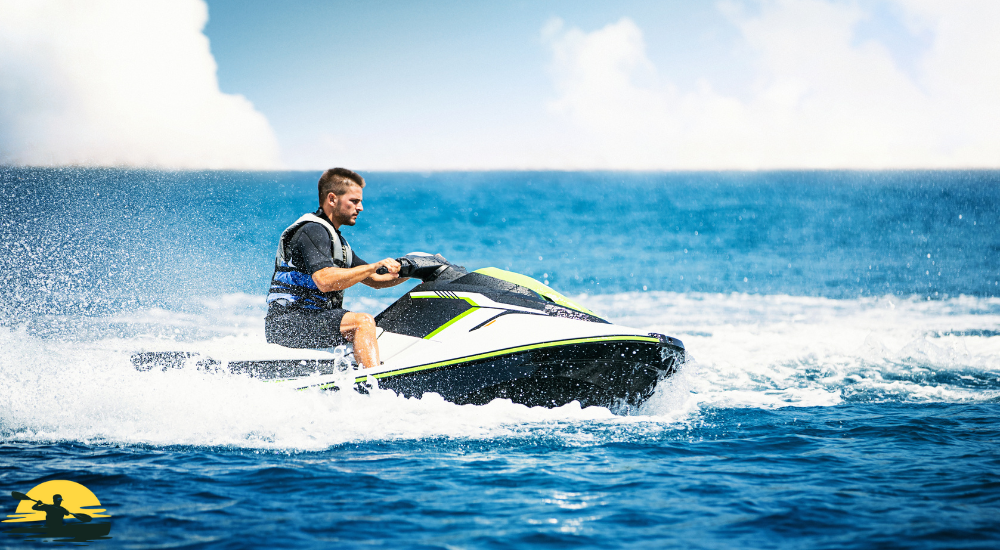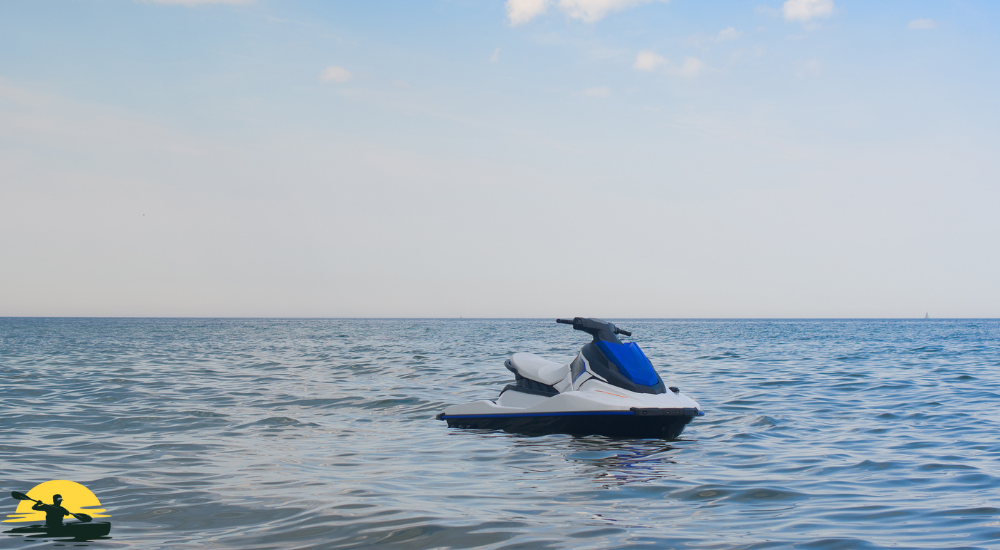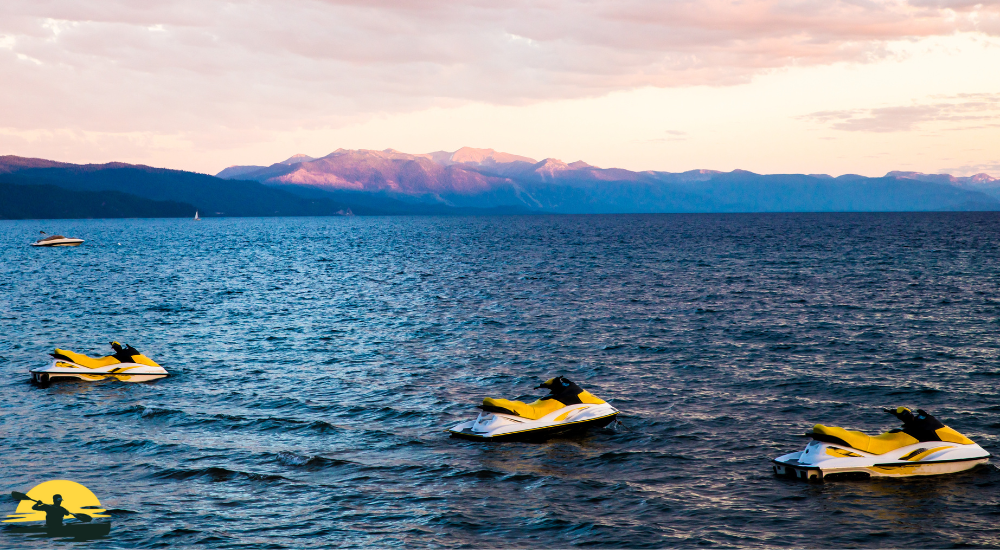
Have you ever wondered how those zooming jet skis work?
Unlike boats with propellers, jet skis use a special kind of engine called a jet propulsion engine. This engine sucks in water from underneath and shoots it out the back.
But that’s not all! This forceful water stream creates an equal and opposite reaction, pushing the jet ski forward.
In this guide, we’ll explain this system step-by-step so you can impress your friends with your jet ski knowledge!
- Jet skis use a jet propulsion system, not propellers, to move.
- The engine powers an impeller that sucks in water and shoots it out the back, creating thrust.
- This thrust propels the jet ski forward due to Newton’s Third Law of Motion (action and reaction).
- Steering is achieved by adjusting the direction of the jet nozzle.
- Regular maintenance is crucial for safety and optimal performance.
- Electric jet skis are becoming more popular due to their environmental friendliness and quiet operation.
Key Components of a Jet Ski
Alright, let’s get to know the key players in this jet ski show.
Each part has a special job to do:

- The Jet Ski Engine: This is the heart of the whole operation, like the engine in your car. Most jet skis use small but powerful two-stroke or four-stroke engines. These engines create a spinning force that drives the whole propulsion system.
- The Impeller: Imagine a fan inside a tube. That’s basically what an impeller is. It spins super fast, sucking water in from underneath the jet ski and then shooting it out with a ton of force.
- The Jet Nozzle: This is the exit ramp for the water. It’s a small opening at the back of the jet ski where all that pressurized water gets blasted out. And because this jet is shooting backward, it creates a backward pulling force. This force, in turn, pushes the PWC forward, just like when you step off a skateboard; it shoots out behind you.
- The Steering Nozzle: This nozzle is attached to the handlebars and can move from side to side. By changing the direction of the water jet, you can steer the jet ski.
- The Cooling System: Jet ski engines create a lot of heat, so they need a way to cool down. That’s where the cooling system comes in. It uses water from the lake or ocean to keep the engine from overheating. This is different from how a car’s radiator works with chemicals.
See, it’s pretty simple! These main parts work together to make the jet ski go vroom across the water.
How a Jet Ski Operates
Alright, let’s see this jet ski in action.
Think of it like a chain reaction, where one step leads to the next:

- Starting the Engine: It’s just like starting a car. You turn the key, and the engine comes to life.
- Water Intake: Underneath the jet ski, there’s a grate called the intake grate. When the engine starts, the impeller begins to spin, creating a vacuum that sucks water up through this grate. It’s like the jet ski is taking a big gulp of water.
- Building Pressure: Now, the impeller acts like a water pump, pushing this water into a narrow pipe called the jet pump. This squeezing action creates a powerful jet of water.
- Jet Propulsion: This high-speed jet of water blasts out of the jet nozzle at the back of the jet ski. Do you know how rocket engines work by shooting hot gases out the back to push the rocket forward? It’s the same idea here, except we’re using water.
- Action and Reaction: Remember learning about “action and reaction” in science class? Here’s where it gets cool. As the jet of water shoots backward, the jet ski is pushed forward with equal force. This is how the jet ski moves!
- Steering: Want to turn? Easy! When you move the handlebars, it adjusts the steering nozzle, changing the direction of the water jet. Aim the plane to the right, and the jet ski turns right. Aim left, and it turns left.
Pretty neat, huh? It’s all about using the power of water to make the jet ski go where you want it to.
Maintenance and Safety Tips
Just like your mom or dad’s car, jet skis need to be maintained to keep them running smoothly and safely.
It’s not just about making sure the jet ski works well; it’s also about keeping you safe on the water. So, here are some things to keep in mind:

- Engine Care: This is super important! Jet skis need regular check-ups, just like cars. This means changing the oil, checking the spark plugs, and making sure the engine is happy. It’s a good idea to get a grown-up to help you with this or take it to a shop that knows how to work on jet skis.
- Impeller Check: That spinning impeller can get worn down over time. It’s a good idea to check it every so often and replace it if it’s looking rough.
- Cooling System Flush: Remember, water keeps the engine cool. Every so often, flush the cooling system with fresh water to get rid of any salt or gunk that might build up.
- life jackets: Always, always, always wear a life jacket when you’re on a jet ski. It doesn’t matter if you’re a great swimmer; accidents can happen to anyone.
- Follow the Rules: The Coast Guard makes rules about where and how you can ride jet skis. Make sure you know the rules for your area and follow them.
Remember, a jet ski is a powerful machine, so it’s important to be responsible and safe when you’re riding.
Factors to Consider
Okay, it’s time to pick the perfect jet ski!
There are a few things to think about before you jump in:
- Type of Jet Ski:
- Stand-up: These are for one person and are made for tricks and racing. They’re not as easy to ride as sit-down jet skis.
- Sit-down: These can fit two or three people and are better for cruising and having fun with friends or family.
- Engine Size: Bigger engines mean more power and speed, but they also use more gas. Smaller engines are better for beginners.
- Features: Some jet skis come with cool extras like storage compartments, cup holders, or even speakers. Think about what would make your jet ski adventures more fun.
- Price: Jet skis can cost a lot of money, so it’s important to think about your budget. You can find both new and used jet skis, so there are options for different price ranges.

Remember, choosing a jet ski is kind of like choosing a bike.
You want one that’s the right size and has the features you need for what you want to do.
If you’re not sure, ask a grown-up to help you, or maybe even try renting a few different types of jet skis to see what you like best.
The Future of Jet Skis: Innovations and Trends
Get ready because the future of jet skis is looking pretty cool!
Companies are coming up with new ideas to make jet skis even more fun and better for the environment.
Here’s what you might see in the coming years:
- Electric Jet Skis: Some jet skis are ditching gas engines and going electric, kind of like electric cars. This means quieter rides and no smelly exhaust fumes! Plus, it’s better for the planet because there’s no pollution.
- High-Tech Steering: We might see jet skis with fancy new steering systems that make them even easier to control. Imagine being able to turn and do tricks with just a flick of your wrist!
- Gadgets Galore: Think about jet skis with GPS systems to help you navigate, fancy displays that show you all sorts of information, and even built-in speakers for your favorite tunes.
All of these innovations are thanks to the same basic principle we talked about earlier: Newton’s Third Law.
Jet skis are always going to be about that action-reaction force, whether they’re powered by gas, electricity, or something we haven’t even thought of yet!
Conclusion

So there you have it! Jet skis aren’t magic, but they’re pretty awesome examples of how we can use simple science to have a blast on the water.
Remember, it all starts with the engine, which powers that spinning impeller. The impeller sucks in water and shoots it out, creating that awesome jet that pushes you forward.
The next time you see someone zooming by on a jet ski, you’ll know exactly what’s going on under the hood (or should I say, under the hull?).
And maybe, just maybe, you’ll be inspired to give jet skiing a try yourself! Just remember to be safe, follow the rules, and have a blast riding the waves.
Frequently Asked Questions
What is the difference between a jet ski and a boat?
Jet skis are a type of personal watercraft (PWC) that use a jet propulsion system to move, while traditional boats use an external propeller. PWCs are generally smaller and more agile than boats.
How does a jet ski engine work?
Similar to a car engine, a jet ski engine burns fuel to create power. However, instead of turning wheels, it spins an impeller, which acts like a motorized fan. The impeller draws water in and shoots it out, creating thrust. Jet ski impeller work is very important.
Why doesn’t a jet ski have a propeller?
Jet skis don’t need propellers because they use a different propulsion system. The impeller inside the jet ski creates a jet of water that pushes it forward, eliminating the need for an external propeller.
Is a jet ski safe?
Like any watercraft, jet skis have inherent risks. However, following safety guidelines, wearing a life jacket, and operating responsibly can greatly reduce those risks. Jet pushing backward is one the most powerfull thing that happened in jet ski engine.
What happens if a jet ski engine collides with something in the water?
The jet ski engine is designed to ingest water, so hitting a small object like a stick usually won’t cause damage. However, colliding with a larger object or running aground can cause serious damage to the impeller or other parts of the jet propulsion system.










